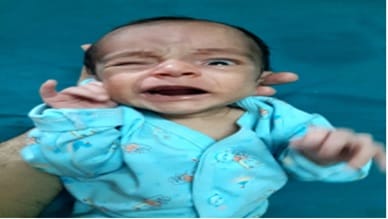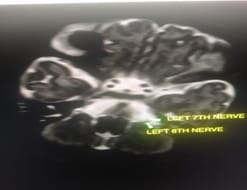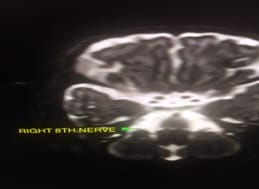Congenital unilateral absence of facial nerve with hypoplastic abducens nerve: A case report of rare Moebius syndrome
Dharmani A.1, Kashyap S.2, Thakur S.3, Guleria S.4*
DOI: https://doi.org/10.17511/ijpr.2020.i06.13
1 Ankur Dharmani, MD, Department of Pediatrics, Regional Hospital, Bilaspur, Himachal Pradesh, India.
2 Sonia Kashyap, MD Internal Medicine, Deen Dayal Upadhayay Hospital, Shimla, Himachal Pradesh, India.
3 Swati Thakur, MD, Department of Radiodiagnosis, Phoenix Diagnostic Center, Bilaspur, Himachal Pradesh, India.
4* Sandesh Guleria, MD, DM, Assistant Professor, Department of Pediatrics, Indira Gandhi Medical College, Shimla, Himachal Pradesh, India.
Moebius syndrome is a rare congenital neurological disorder characterized by bilateral facial and abducens nerve paralysis. The syndrome may also include involvement of the other cranial nerves and various other congenital deformities and malformations. A one-month-old male infant presented with facial asymmetry, inability to close eye, and drooling of saliva from one side of the mouth, diagnosed to have Moebius syndrome. Early diagnosis of the cases by experienced clinicians and a supportive multidisciplinary approach can help children with Moebius syndrome and prevent associated complications.
Keywords: Moebius syndrome, Abducens nerve paralysis, Congenital deformities
| Corresponding Author | How to Cite this Article | To Browse |
|---|---|---|
| , MD, DM, Assistant Professor, Department of Pediatrics, Indira Gandhi Medical College, Shimla, Himachal Pradesh, India. Email: |
Dharmani A, Kashyap S, Thakur S, Guleria S. Congenital unilateral absence of facial nerve with hypoplastic abducens nerve: A case report of rare Moebius syndrome. Pediatric Rev Int J Pediatr Res. 2020;7(6):310-312. Available From https://pediatrics.medresearch.in/index.php/ijpr/article/view/618 |


 ©
© 

